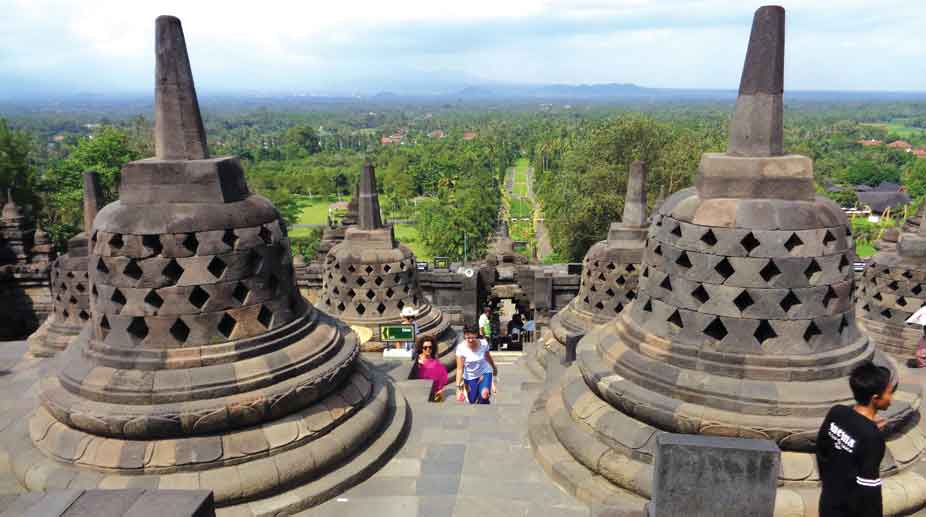In its heyday, pilgrims could see the magnificent panoramic view of Borobudur from miles away, its spire rising 23 metres towards the heavens. Today, while approaching the monument from the Indonesian city of Yogyakarta, I found that view of the stupa is no longer available, due to dense tree coverage of the newly developed Archeological Park that surrounds it.
I got the overall orientation only after reaching the top of the edifice. The original site for the stupa, as mentioned in the guidebook, was at the confluence of two rivers (as mystical Mount Meru in India had been built). Today it sits on a vast flat plain with two volcanoes on one side, simmering rice paddies on another, towering mountain on a third.
On first sight what impressed me about Borobudur were not its size, but its symmetry (a very deceptive symmetry, as I discovered) and its settings. And, yes I was also overwhelmed by the statistics. Borobudur is the largest religious building in the southern hemisphere, constructed more than a millennium ago, without mortar, with 1,600,000 stones fitting into one another. It has almost five kilometres of carvings, 2,000 beautifully sculpted panels along its galleries, hundreds of Buddha images.
But the numbers are dwarfed by something else, something harder to grasp than the world of figures. To start with it is not an architecture meant for occupying or holding a defined space. Borobudur stupa doesn’t enclose space; while being mystical and magical at the same time.
What exactly was it? Borobudur didn’t represent the state religion of eighth century Java (or Jambu Dwipa). If anything, the major religion then was Hinduism, brought by Indian Brahmins and soldiers who lived throughout the country. Buddhists came from India later and started the plans for Borobudur in about 790 AD. So, many theological ideas are expressed architecturally in the single subject. It is a microcosm of the earth and spirit.
The best time to visit Borobudur is early dawn. At that time, silence and peace of the setting is awesome. The mist hangs off the palm trees, the dew glistens on the grass, and the far away volcanoes are dark silhouettes. Now the slate-grey stones of Borobudur are glowing with pink and the mass seems far larger. The pink turns to rose, and then the light changes to gold, and the stupa changes with it. And, the Borobudur looks magnificent and slightly foreboding as I begin to climb.
The carvings and bas reliefs in stone depict the Great Wheel of Buddhism in three stages or three states. First the world of desire and the senses. Then nature, earthy form, the Buddha on Earth. And finally, the world beyond form, the world of perfect nothingness. So, each higher terrace suggests the gradual disappearance of the need for sense.
On the bottom row, there are a few carvings in stone. On the south east corner of the stupa are some panels showing the world of people of everyday life. Most have been obliterated, but the realism makes one to climb higher.
The following terraces show the second state. We walked up the first three terraces while enjoying the carvings and bas reliefs on stone. They are all perfectly square. One feels, in walking around, that one is closed into a geometric zone, which is somehow binding, locking one in.
Yet the sculptures are astonishing — the story of the birth of the Buddha, the Queen relating her dream, the life of the Buddha and the gods, of course Buddha’s confrontation with the old man, poor man and dead man, his enlightenment. They comprise the inner walls. On the outer walls are panels without end with its plethora of real and mythical animals, its symbols of flowers and clusters of abstract designs and hints of a secret world — heaven, hell or somewhere in-between … who knows.
From that gallery on, the panels have disappeared. The material world has gone. Instead one finds 72 miniature stupas with latticed windows and statues of Buddha inside each of them. For luck, one should reach in and attempt to touch each Buddha statue. On the very top, the main stupa is placed on a double lotus. The stupa is closed. Inside is an empty space that may — or may not — have held a statue or relic.
While multi-religious tourists and visitors far outnumber them, the actual pilgrims are still sizable in numbers. But, this is not a temple and not a place for prayer; the pilgrims come for meditation. They walk clockwise nine times around the great stupa, each time climbing a staircase until they reach the top. They know here that space is infinite, there is nothingness, neither consciousness nor unconsciousness.
Look at it without the knowledge of Buddhism and the Great Wheel and one is still astonished. Borobudur is a large and intricate masterpiece, a thing of heavenly beauty, an illustrated scripture, a fantastic philosophy encapsulated in stone. There is no place on earth you would see a Borobudur or something remotely similar to it. To any comer it continues to mystify and enlighten simultaneously.












